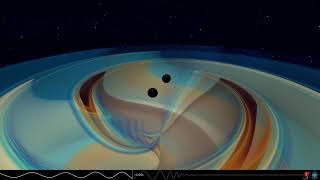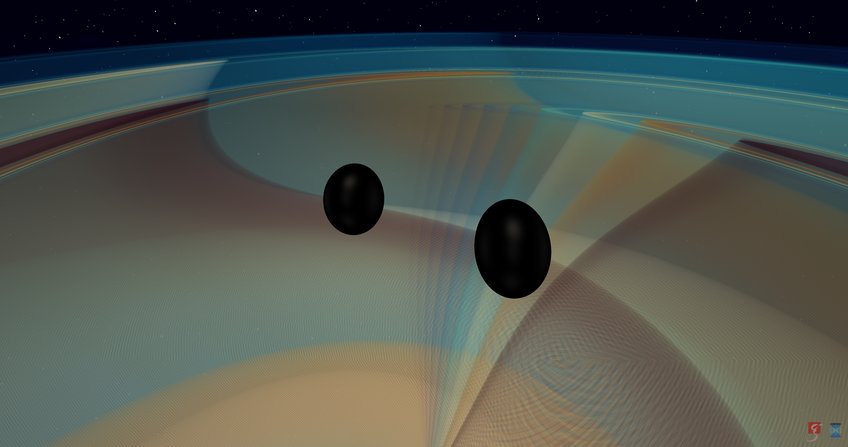LIGO and Virgo catch their biggest fish so far
Far-away black hole collision is the most massive and most distant ever observed by the gravitational-wave detectors
The fourth gravitational-wave detection from LIGO’s and Virgo’s third observing run published today is very big news: the most massive merger of two black holes ever observed to date. The black-hole collision formed a 142 solar-mass black hole when the Universe was half its current age. This is the first direct observation of the birth of an intermediate-mass black hole. Even more surprising is the heavier black hole in the pair: with 85 times the mass of our Sun, it should not exist according to the current understanding of stellar explosions, but it could be born from an earlier binary merger. It is unknown whether this signal, GW190521, is the first observed representative of a new class of binary black holes or is simply at the upper end of a wide mass spectrum. Scientists at the Max Planck Institute for Gravitational Physics in Potsdam and Hannover and at the Leibniz University Hannover have made crucial contributions to the discovery and its interpretation.
Today the LIGO Scientific Collaboration and the Virgo Collaboration have published the latest observational results and their astrophysical implications in the journals Physical Review Letters and Astrophysical Journal Letters. GW190521 was observed by the twin LIGO detectors and the Virgo detector on May 21, 2019 – early on in their third-joint observing run O3, which began on April 1, 2019.
Numerical simulation of a heavy black-hole merger (GW190521)
“Right from the beginning this signal, which is only a tenth of a second long, challenged us in identifying its origin”, says Alessandra Buonanno, director at the Max Planck Institute for Gravitational Physics (Albert Einstein Institute; AEI) in Potsdam and College Park professor at the University of Maryland. She adds, “But, despite its very short duration, we were able to match the signal to one expected of black-hole mergers, as predicted by Einstein’s theory of general relativity, and we realized we had witnessed, for the first time, the birth of an intermediate-mass black hole from a black-hole parent that most probably was born from an earlier binary merger.”
A short message from a galaxy far, far away
GW190521 is the fourth gravitational-wave signal published from O3, and it is rather short: It lasted about a tenth of a second and has four gravitational-wave cycles (corresponding to two orbits of the black holes) in the frequency band of the detectors. During this short time, its frequency chirps up from 30 Hertz to 80 Hertz before the signal ends with the merger of the two black holes.
GW190521 is not only the binary black hole merger with the highest total mass observed so far, it is also the most distant. Because of the high mass, very strong gravitational waves – with an energy equivalent to eight times the mass of the Sun – were emitted, making the signal loud and recognizable over large cosmological distances. The merger with a total mass of almost 150 Suns happened when the Universe was half its current age: about seven billion years ago.
Witnessing the birth of an intermediate mass black hole
The remnant of the merger of the two black holes, one with 66 and the other with 85 solar masses, is a black hole of 142 solar masses. This is heavier than any LIGO/Virgo black hole observed before and is the first direct observation of an intermediate mass black hole’s birth. This elusive, so far postulated, and previously only indirectly observed class of black holes is characterized by their masses of 100 to 100,000 times that of our Sun – more massive than the known lighter stellar mass black holes and less massive than the heavier supermassive black holes at the centers of galaxies.

A black hole that shouldn’t exist
The heavier black hole in the pair is even more surprising: Its mass of 85 times our Sun does not fit at all into models of stellar evolution.
“From our understanding of how stars age and evolve we expect to find black holes with either less than 65 solar masses or more than 120 solar masses, but none in between,” explains Frank Ohme, leader of an Independent Max Planck Research Group at AEI Hannover. “The 85 solar-mass black hole in the GW190521 origin system falls right in that gap where it shouldn’t be! This can mean two things: our understanding of stars evolution is incomplete or something different has happened here.”
A gap in black hole masses
According to current understanding, stars which would give birth to black holes with masses between 65 and 120 solar masses do not explode as supernovae, and therefore no such black holes are formed. The stars rather experience one or more short episodes of instability in each of which they expel a significant fraction of their mass instead of exploding entirely. At the end of this process, a star is left that explodes in a supernova and creates a black hole of less than 65 solar masses. Stars that would form black holes of more than 120 solar masses are expected to directly collapse without the accompanying firework of a supernova.
The resulting gap in the black hole mass spectrum is called the “pair instability” gap. It is named after the physical process causing the episodes of mass shedding.
A merger of merged black holes or stars
The binary system might have had a more complex origin story. Uncertainties in the understanding of how stars evolve might allow for black holes with more than 65 solar masses to be born from supernova explosions. However, LIGO and Virgo researchers think the most likely explanation for formation the 85 solar-mass object is the earlier merger of two smaller black holes or that of two massive stars.
Something completely different
While the signal is well described by and agrees with what Einstein’s theory of general relativity predicts for a binary black hole merger, LIGO and Virgo scientists also look at other possible explanations for their observation in a companion paper. The origin from cosmic strings – a hypothetical object that could have formed in the early Universe – seems unlikely. The signal also is unlikely to come from a core collapse supernova, which would be accompanied by electromagnetic or neutrino signals.
The GW190521 observation is also consistent with coming from a closer and less massive binary black hole merger, the gravitational waves of which have been distorted through a gravitational lens. It could also stem from primordial black holes that formed in the early Universe before stars were even born. However, LIGO and Virgo researchers have determined that both of these explanations as very unlikely compared to the regular merger scenario. Lastly, the signal could have been produced by a merger of two black holes on elliptic orbits. But to check that, accurate signal models including the fingerprints of elliptic orbits derived from general relativity have to be matched against the signal. They are not yet available.
A new class of binary black holes?
“We don’t know yet whether GW190521, this surprising discovery and first observation of an intermediate mass black hole, is an entirely new class of binary black holes or just the high-mass end of the source spectrum we’ve seen so far,” says Karsten Danzmann, director at the AEI Hannover, and director of the Institute for Gravitational Physics at Leibniz University Hannover. “Soon, when we have analyzed all binary black hole mergers seen by LIGO and Virgo in their third observing run we might know more.”
A future publication will analyze the larger sample of binary black hole mergers observed in the first half of O3 (O3a from 1 April through 1 October, 2019).
AEI researchers contributed to detecting and analyzing GW190521. They have provided accurate models of the gravitational waves from coalescing black holes that included, for the first time, the precession of the black-holes’ spins, and multipole moments beyond the dominant quadrupole. Those features imprinted in the waveform are crucial to extract unique information about the source’s properties. The high-performance computer cluster “Hypatia” at AEI Potsdam was employed to develop the waveform models used for the analyses.
More than 50 additional gravitational-wave candidates from O3
The LIGO and Virgo researchers have issued alerts for 56 possible gravitational-wave events (candidates) in O3, which lasted from 1 April 2019 to 27 March 2020. So far, four candidates have been confirmed and made public. LIGO and Virgo scientists are examining all remaining 52 candidates and will publish all those for which detailed follow-up analyses confirm their astrophysical origin.
LIGO Scientific and Virgo Collaborations
LIGO is funded by the National Science Foundation (NSF) and operated by Caltech and MIT, which conceived of LIGO and lead the project. Financial support for the Advanced LIGO project was led by the NSF with Germany (Max Planck Society), the U.K. (Science and Technology Facilities Council) and Australia (Australian Research Council-OzGrav) making significant commitments and contributions to the project. Approximately 1,300 scientists from around the world participate in the effort through the LIGO Scientific Collaboration, which includes the GEO Collaboration. A list of additional partners is available at https://my.ligo.org/census.php.
The Virgo Collaboration is currently composed of more than 500 scientists, engineers, and technicians from 99 institutes from Belgium, France, Germany, Hungary, Italy, the Netherlands, Poland, and Spain. The European Gravitational Observatory (EGO) hosts the Virgo detector near Pisa in Italy, and is funded by Centre National de la Recherche Scientifique (CNRS) in France, the Istituto Nazionale di Fisica Nucleare (INFN) in Italy, and Nikhef in the Netherlands. A list of the Virgo Collaboration members can be found at http://public.virgo-gw.eu/the-virgo-collaboration/. More information is available on the Virgo website at http://www.virgo-gw.eu.

